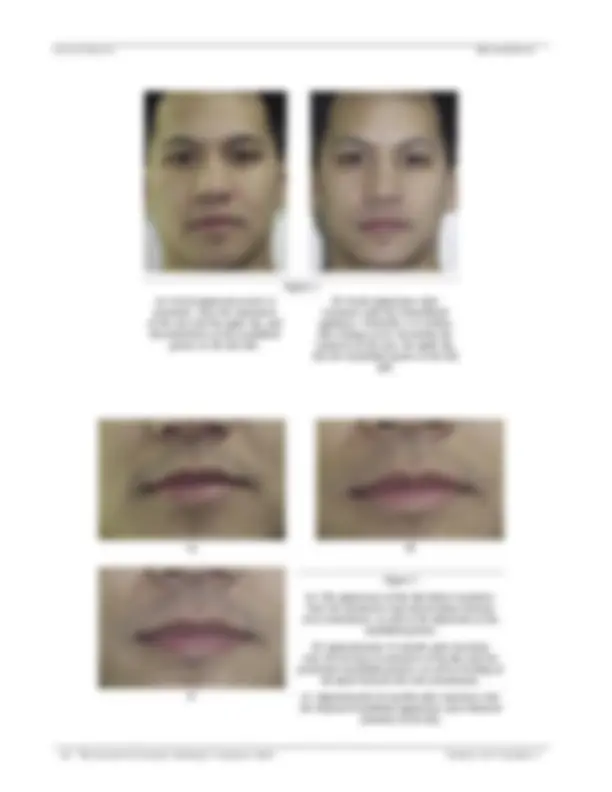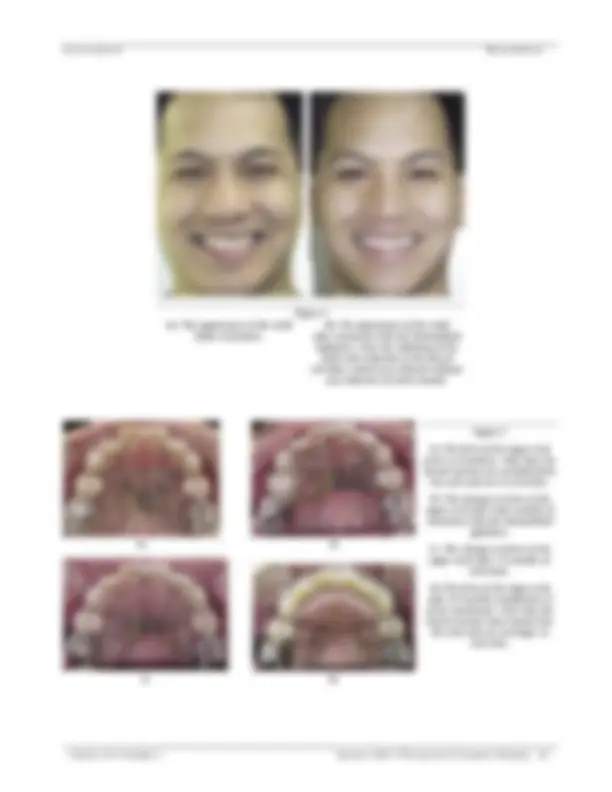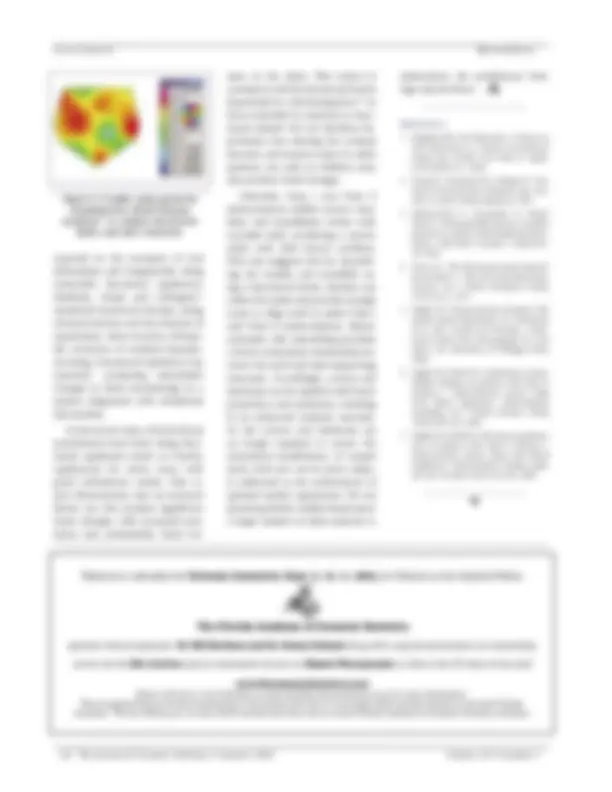





Study with the several resources on Docsity

Earn points by helping other students or get them with a premium plan


Prepare for your exams
Study with the several resources on Docsity

Earn points to download
Earn points by helping other students or get them with a premium plan
Community
Ask the community for help and clear up your study doubts
Discover the best universities in your country according to Docsity users
Free resources
Download our free guides on studying techniques, anxiety management strategies, and thesis advice from Docsity tutors
A case report on the use of the Homeoblock™ appliance, an intraoral device developed by Dr. Belfor and Dr. Singh, which produces cosmetic facial enhancement without invasive procedures. The report demonstrates the device's ability to widen the arch form and smile, reduce the buccal corridor, and increase facial symmetry in a 38-year-old male patient. The authors also discuss the potential use of this new intraoral protocol in cosmetic dental practice as an alternative to surgery or invasive procedures.
What you will learn
Typology: Exercises
1 / 5

This page cannot be seen from the preview
Don't miss anything!




80 The Journal of Cosmetic Dentistry • Summer 2004 Volume 20 • Number 2 Note: Dr. Belfor and Dr. Singh developed and have a U.S. Patent pending on the Homeoblock™ appliance, the device described in this article.
This case report introduces a new intraoral device, the Homeoblock™ appliance (Orthovisage Inc; New York, NY), which produces cosmetic facial enhance- ment without an invasive procedure. Furthermore, this particular case demonstrates widening of the arch form and smile, and reduction of the buccal corridor with- out reducing tooth structure. Indeed, robust geometric analysis was undertaken to confirm the clinical find- ings, which localized and quantified the facial regions in which changes produced by the intraoral device were identifiable. This new intraoral protocol may be used in cosmetic dental practice as an alternative to surgery or other invasive procedures to enhance facial esthetics. This report demonstrates that an intraoral device can also produce significant facial changes, with increased symmetry and, presumably, facial volume, in the adult.
Dr. Theodore Belfor graduated from New York University College of Dentistry in 1966, after which he served as a Bri- gade Dental Surgeon, 196th Lt. Infantry, Chu Lai, Vietnam. He holds diplomas from numerous organizations, including the American Society for Dental Aesthetics and the Brane- mark Institute for Osseointegration. He has lectured in the United States, Puerto Rico, and India; and has been pub- lished in Anti-Aging and Cosmetic Surgery Magazine_. Dr. Belfor, who once served as the dental director of American Healthcare Ltd., in Beijing, China, currently practices gen- eral dentistry in New York City. Dr. G. Dave Singh is a professor at the Center for Craniofa- cial Disorders at the University of Puerto Rico School of Med- icine in San Juan. He leads an NIH-funded program of cra- niofacial research, which uses advanced imaging technologies to model clinical treatments and craniofacial anomalies. Dr. Singh, who was born, educated, and trained in England, has published extensively in peer-reviewed dental and orthodon- tic journals and has developed geometric morphometric soft- ware for 3-D and 2-D analyses. He is a member of the Amer- ican Association of Orthodontists and the Appliance Therapy Practitioners Association. by_ Theodore R. Belfor, D.D.S.; and G. Dave Singh, D.D.Sc., Ph.D., B.D.S.
Volume 20 • Number 2 Summer 2004 • The Journal of Cosmetic Dentistry 81 Figure 1: The Homeoblock™ appliance.
This case study reports facial changes that are consistent with increased facial symmetry and, per- haps, facial volume. A 38-year-old male with no relevant negative med- ical history requested treatment to improve his smile. On examination it was found that the upper arch was crowded, with an absence of the sec- ond bicuspids and the lateral inci- sors in a cross-bite relationship. Ex- traoral and intraoral photographs, as well as panoramic and cephalomet- ric radiographs, showed no adverse findings. Alginate impressions were taken for study models and a Ho- meoblock device was fabricated. The device consisted of Adam’s clasps on the first molars, a palatal expansion screw, a Hawley labial bow from cus- pid to cuspid, flap springs for the an- terior teeth, and a bite block on the left (Fig 1). On insertion, the patient was in- structed to wear the appliance every evening and throughout the night. Once a week the expansion screw was advanced by one full turn (= 0. mm), which is about half the width of the periodontal ligament space. The patient reported for clinical adjustments and observation every three weeks; intraoral photographs were taken at each visit. The active treatment time was approximately 24 months, after which a retainer was provided. At the end of active treatment, extraoral and intraoral photographs were taken, as well as alginate impressions for study mod- els. The extraoral facial photographs were assessed for morphometric changes, using MorphoStudio® soft- ware (www.orthovisage.com). RESULTS Clinically, it was evident that changes occurred not only in the dental arch but also on the face (Fig 2). These changes included an increased symmetry of the eyes and the upper lip (Fig 3), and the reduc- tion of the nasolabial groove on the left side of the face after treatment with the Homeoblock appliance. Fig- ure 4 demonstrates the widening of the smile and reduction of the buccal corridors, which was achieved with- out any reduction of tooth enamel. Thus, the upper arch increased in symmetry, and the alignment of the anterior teeth was significantly im- proved (Fig 5). Changes in facial appearance were also assessed using geometric mor- phometrics. The changes in the face were captured graphically (Fig 6), in- dicating a 30% increase in local size extending from the lateral canthus of the right eye to the angle of the mandible, and extending across the nasal and oral regions. A similar in- crease was found extending from the angle of the mandible across the face on the left side, allied with a 15% decrease in size from the left phil- tral crest to the oral commissure on that side. In contrast, a 30% increase in relative size was localized in the mental region, using the pseudo- color scale. Other regions of the face, colored green, indicated areas where no increase or decrease in local size was identifiable. These pseudo-color changes indicate an esthetic increase of the buccal corridors. … by remodeling the maxilla and mandible using a functional device, dentists can widen the smile and provide enough room to align teeth in adult Class I and Class II malocclusions. D ISCUSSION This case report indicates facial changes achieved through the use of a non-surgical functional appliance, which indicates that dentists may be able to alter facial appearances us- ing this new protocol. The idea of using dental appliances is not new; the first removable dental applianc- es date back to the 1880s. Kingsley^1
Volume 20 • Number 2 Summer 2004 • The Journal of Cosmetic Dentistry 83 Figure 4 4a: The appearance of the smile before treatment. 4b: The appearance of the smile after treatment with the Homeoblock appliance. Note the widening of the smile and reduction of the buccal corridors, which was achieved without any reduction of tooth enamel. Figure 5 5a: The form of the upper arch prior to treatment. Note that the lateral incisors are excluded from the arch and are in cross-bite. 5b: The changes in form of the upper arch after nine months of treatment with the Homeoblock appliance. 5c: The changes in form of the upper arch after 22 months of treatment. 5d: The form of the upper arch after 24 months (completion of active treatment). Note that the lateral incisors have moved into the arch and are no longer in cross-bite. 5a 5c 5d 5b
84 The Journal of Cosmetic Dentistry • Summer 2004 Volume 20 • Number 2 reported on the treatment of oral deformities and irregularities using removable functional appliances. Similarly, Haupl and colleagues.^2 employed functional therapy, using intraoral devices and the muscles of mastication. More recently, orthope- dic correction of condylar hypopla- sia using a functional appliance was reported,^3 producing remarkable changes in facial morphology in a patient diagnosed with hemifacial microsomia. In less severe cases, clinical dental practitioners have been using func- tional appliances (such as Hawley appliances) for many years with good orthodontic results. This re- port demonstrates that an intraoral device can also produce significant facial changes, with increased sym- metry and, presumably, facial vol- Figure 6: Graphic using geometric morphometrics (finite-element analysis)6,7^ to compare facial form before and after treatment. ume, in the adult. This notion is consistent with the functional matrix hypothesis in a developing face,4,5^ as bone remodels in response to func- tional stimuli. We can therefore hy- pothesize that altering the occlusal function and muscle action in adult patients, not only in children, may also produce facial changes. Clinically, Class I and Class II malocclusions exhibit narrow max- illary and mandibular arches with crowded teeth, producing a narrow smile with dark buccal corridors. This case suggests that by remodel- ing the maxilla and mandible us- ing a functional device, dentists can widen the smile and provide enough room to align teeth in adult Class I and Class II malocclusions. Simul- taneously, this remodeling provides a better anatomical relationship be- tween the teeth and their supporting structures. Accordingly, crowns and laminates can be applied with better proportion and symmetry, resulting in an enhanced cosmetic outcome. As the crowns and laminates are no longer required to correct the anatomical insufficiency of rotated teeth, their use can be more adept- ly redirected to the achievement of optimal surface appearance. We are planning further studies based upon a larger sample of adult patients to substantiate the preliminary find- ings reported here.
References